Authentic Italian egg pasta dough or pasta all’uovo is made with only 2 ingredients: fresh eggs and flour.
Egg pasta dough is the base dough used to make a huge variety of pasta shapes. Learn this one dough and you’ll be able to make numerous home pasta shapes like pappardelle, fettuccine, tagliatelle, tagliolini, garganelli, lasagna sheets and of course all kinds of stuffed pasta: ravioli, cappellacci, tortellini, fagottini to name a few.
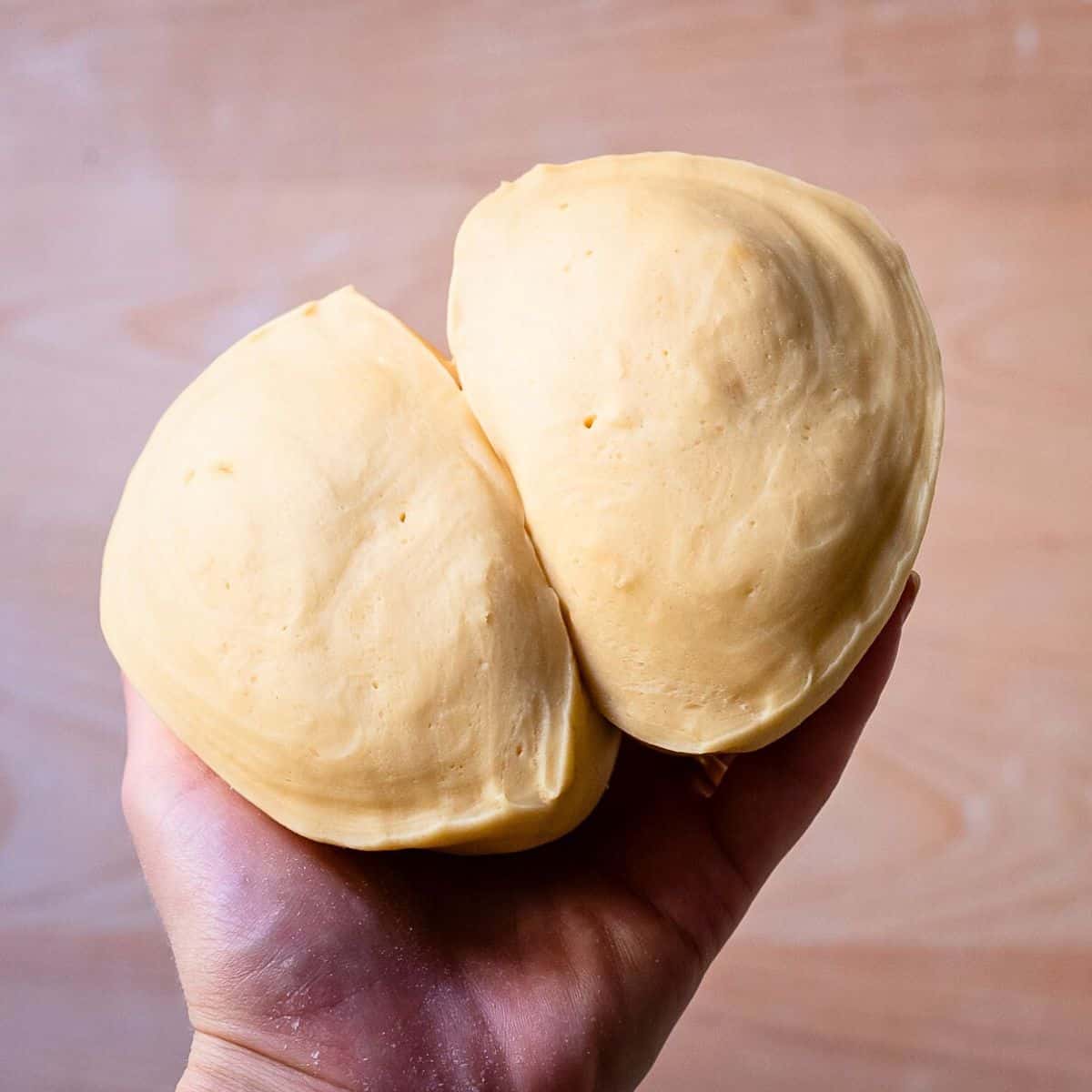
Unlike spaghetti, pasta all’uovo is mostly homemade. It has smooth silky texture and golden hue due to bright color of egg yolks. It’s usually made fresh, just a few hours before serving but can be easily dried (flat pasta shapes) or frozen (stuffed pasta) to have it ready on demand. It’s often called pasta fresca - fresh pasta.
Table Of Contents
Italian Egg Pasta: North vs South
Classic nonna’s formula from North to South calls for 1 egg for every 100 grams of flour. While theoretically correct, practically it can’t be further from the truth. We’ll get to this in just a moment.
What makes egg pasta from the North different from the one made in the South of Italy is the flour. In Northern regions of Italy it’s made with type “00” flour - a refined finely ground softwheat flour obtained from the innermost part of the wheat grain.
As you move down the boot to Central regions, you’ll find that a percentage of soft wheat flour is replaced with durum wheat flour called semola rimacinata or remilled semolina flour until it’s replaced completely with semola rimacinata in the South and on the islands (Sardinia and Sicily).
These variations stem from the climate and, consequently, the distinct agricultural conditions of the North and South. Durum wheat thrives in warmer climates with higher average temperatures, while soft wheat flourishes in cooler environments.
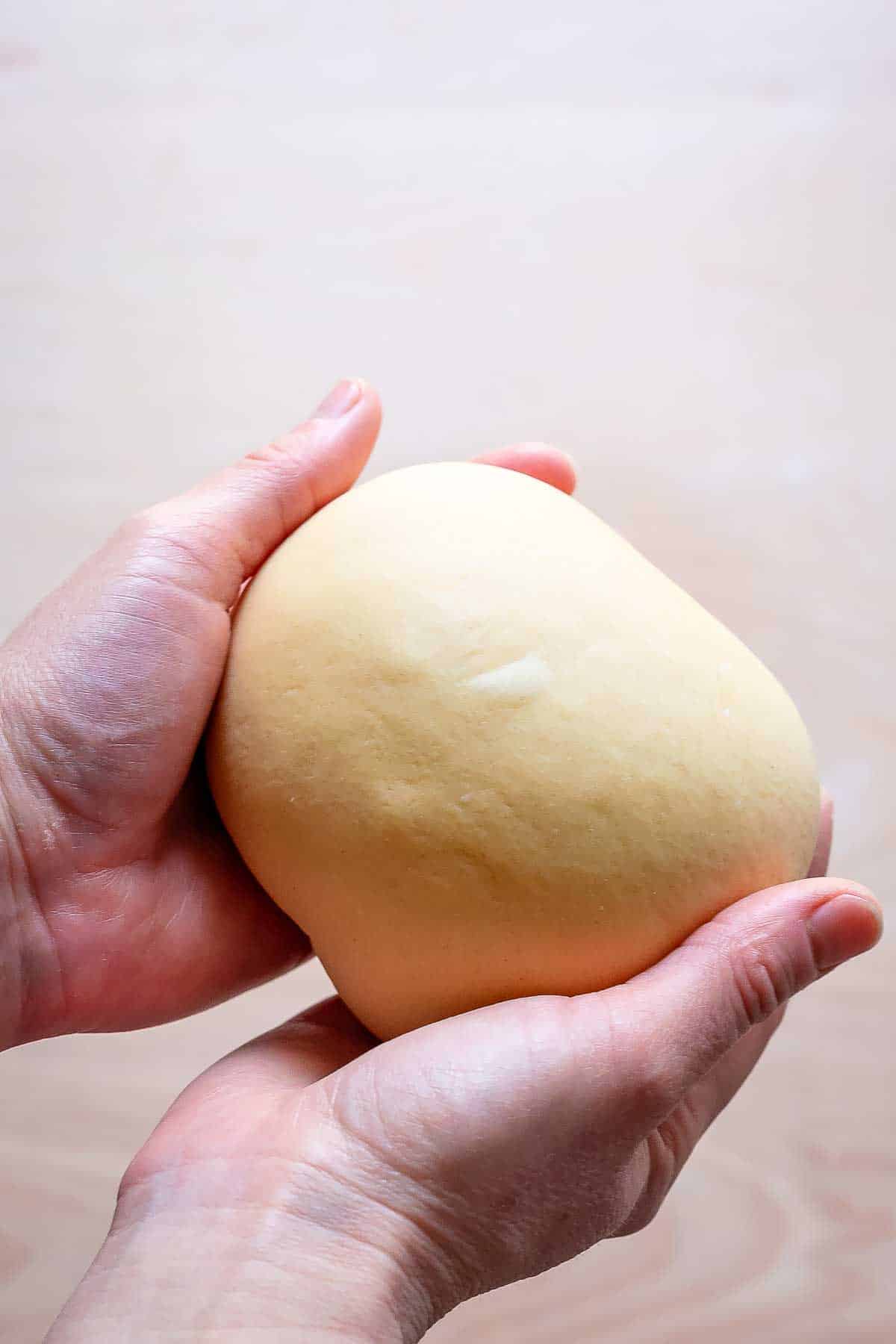
A Rule or a Myth: 1 egg x 100 g flour ?
You’ve likely heard this Italian rule when making egg pasta dough: use 1 egg for every 100 grams of flour - the amount good for one fresh pasta serving.
This ratio is easy to remember and this is what every Italian nonna will tell you to follow. But here’s the trick, unless you’re an Italian nonna, who’s been making fresh pasta before she learned to walk, you’ll never be able to make the perfect pasta dough, or better yet - the results will be different everytime you make it.
While nonna will tell you that she uses 1 egg per 100 grams flour what she actually would do is take one egg and add flour “quanto basta” - as much as enough, which in her perception is around 100 grams but in reality can be anywhere from 80 to 110 grams - and that’s a huge difference!
This difference becomes even more significant if you consider that you would normally make fresh pasta with 3 eggs.
What’s nonna’s secret?
I refer to nonna as a staple of an Italian person with a huge experience who has passion and time to make fresh homemade pasta from scratch and turns out perfect every single time.
Nonna or anyone making fresh pasta on more or less regular basil will tell you - the secret is NOT to use 100 grams of flour per egg.
Let’s take a closer look.
If you take 100 grams of flour - it is an absolute, specific amount. If you take 1 egg - its measurement is relative. Classification by size (small, medium, large) vary from country to country. Even if you take eggs from the same carton (same size category) they will all have a slightly different weight.
To make perfect egg pasta following the Italian 1 egg x 100 g flour all your eggs would have to weight 58 grams each (to reach 58% hydration rate of the pasta dough). And that’s not realistic.
Does it mean that pasta making is exclusively for nonnas or selected ones who have the “feeling” for the perfect dough? Not at all!
The secret to making perfect egg pasta even if you’ve never made homemade pasta before is counterintuitive to nonna’s method, but it works. Every single time.
Perfect Egg to Flour Ratio
Instead of playing flour amount “by ear”, weight the eggs first, then weight your flour. Once you know the weight of the eggs multiply it by 1.75 and this will be the amount of flour needed in grams.
Here’s how it works:
- Weight eggs without shell in grams.
- Calculate flour amount (in grams) = Egg weight x 1.75
Example: I use 3 eggs that total weight 140 grams.
Amount of flour needed: 140 x 1.75 = 245 grams.
How To Make Egg Pasta Dough - Step By Step
Before You Start:
- Weight the eggs and note their total weight without the eggshell.
- Calculate how much flour you need: egg weight in grams x 1.75
- Weight the amount of flour needed. Have a little extra flour ready on the side to use if needed.
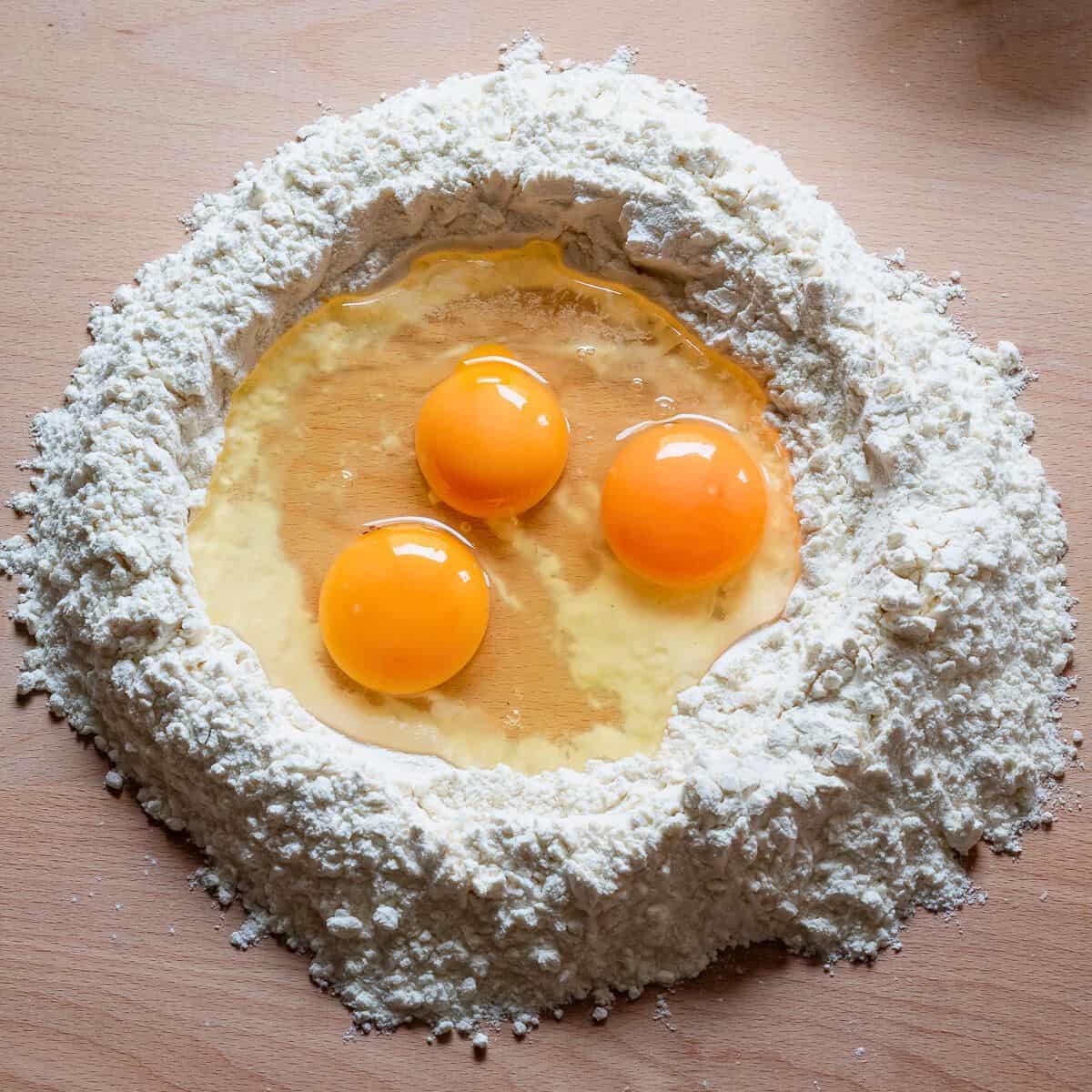
- Sift flour and mound it on a large, preferably wooden surface. Scoop a well in the center and crack in the eggs.
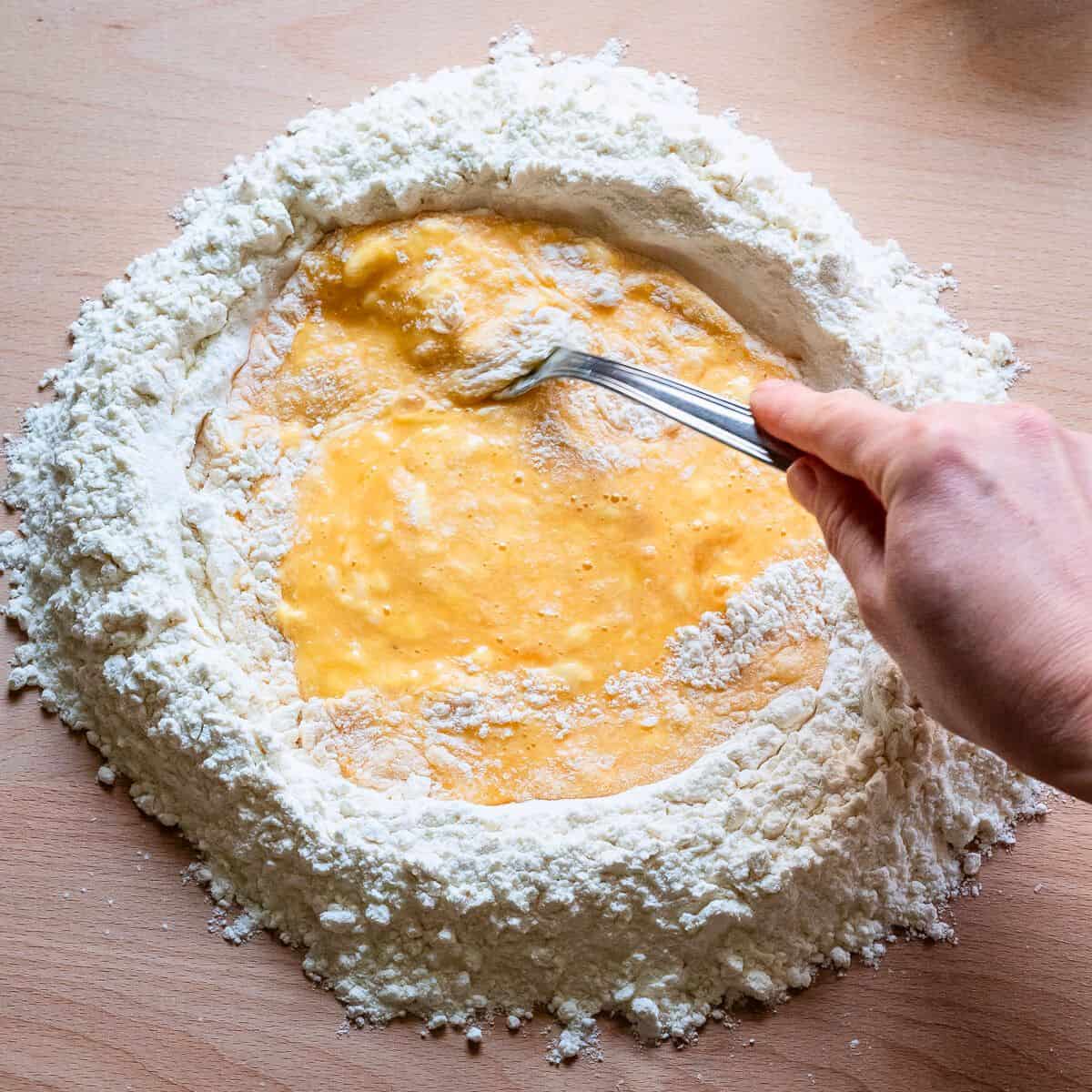
- Beat the eggs with a fork and start incorporating flour from the sides of the well into the egg mix, incorporating a little at a time to avoid the formation of lumps.
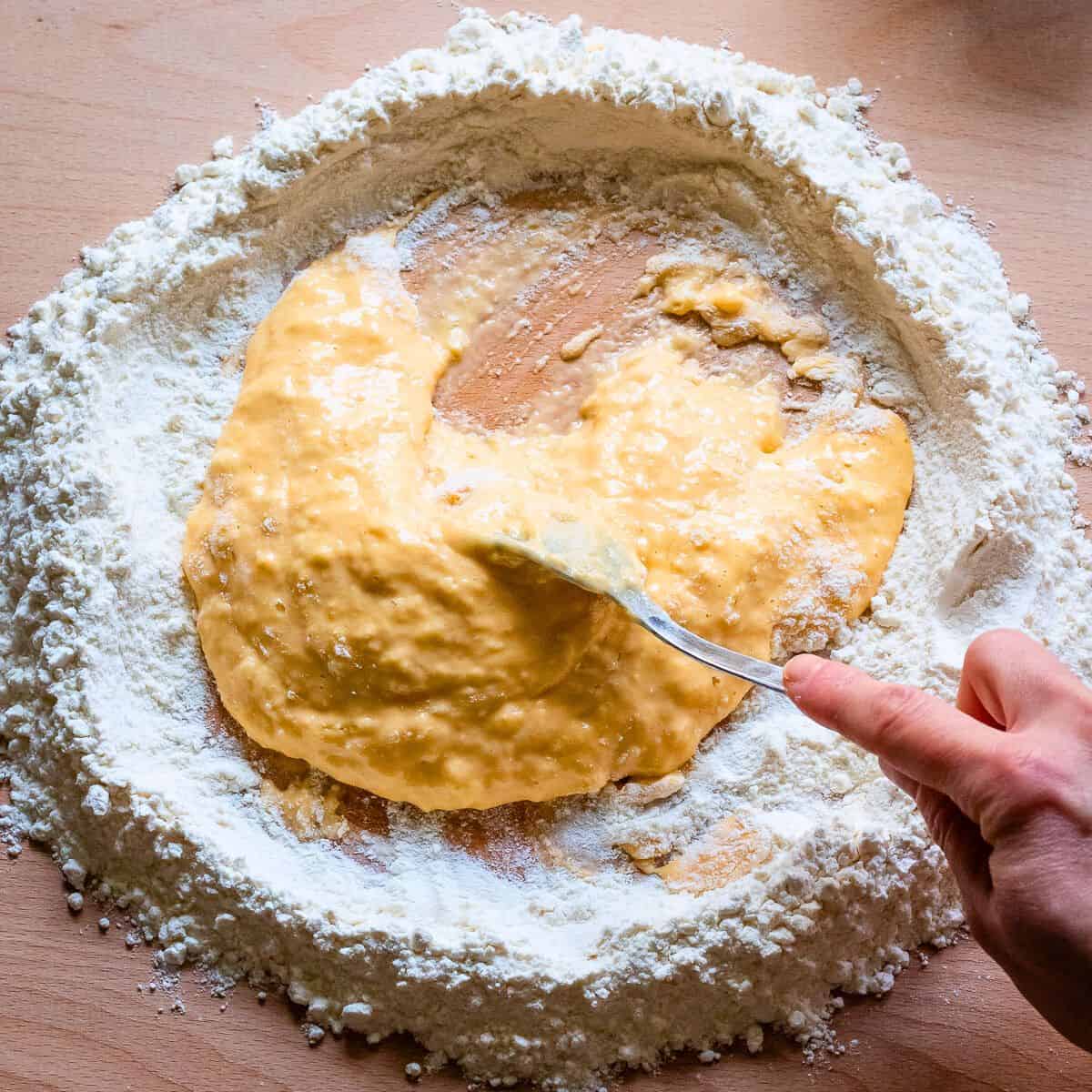
- Notice when egg mixture becomes thick enough so it doesn’t leak from the sides of the flour well.
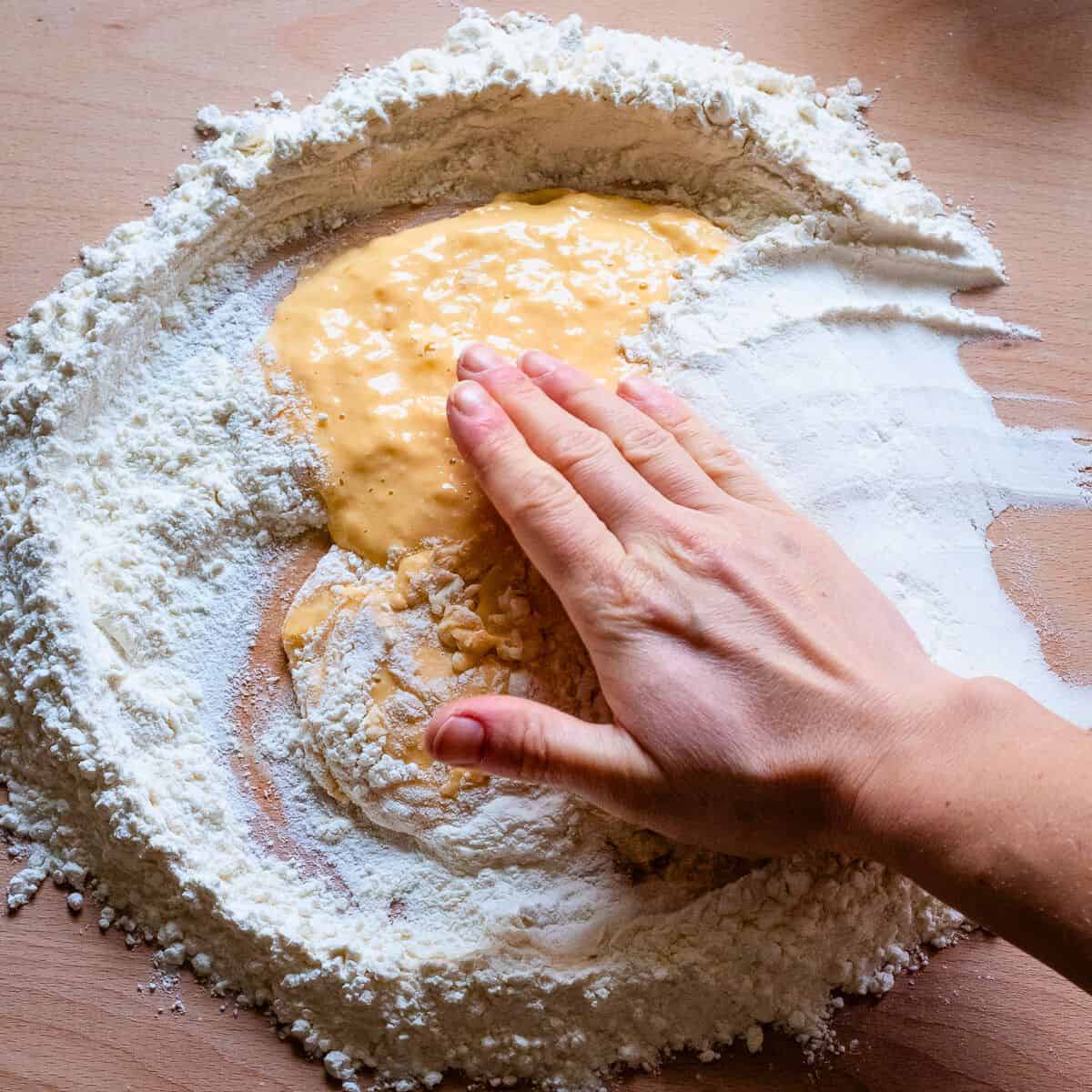
- Cover it with the remaining flour. You can use a dough scraper or your hands.
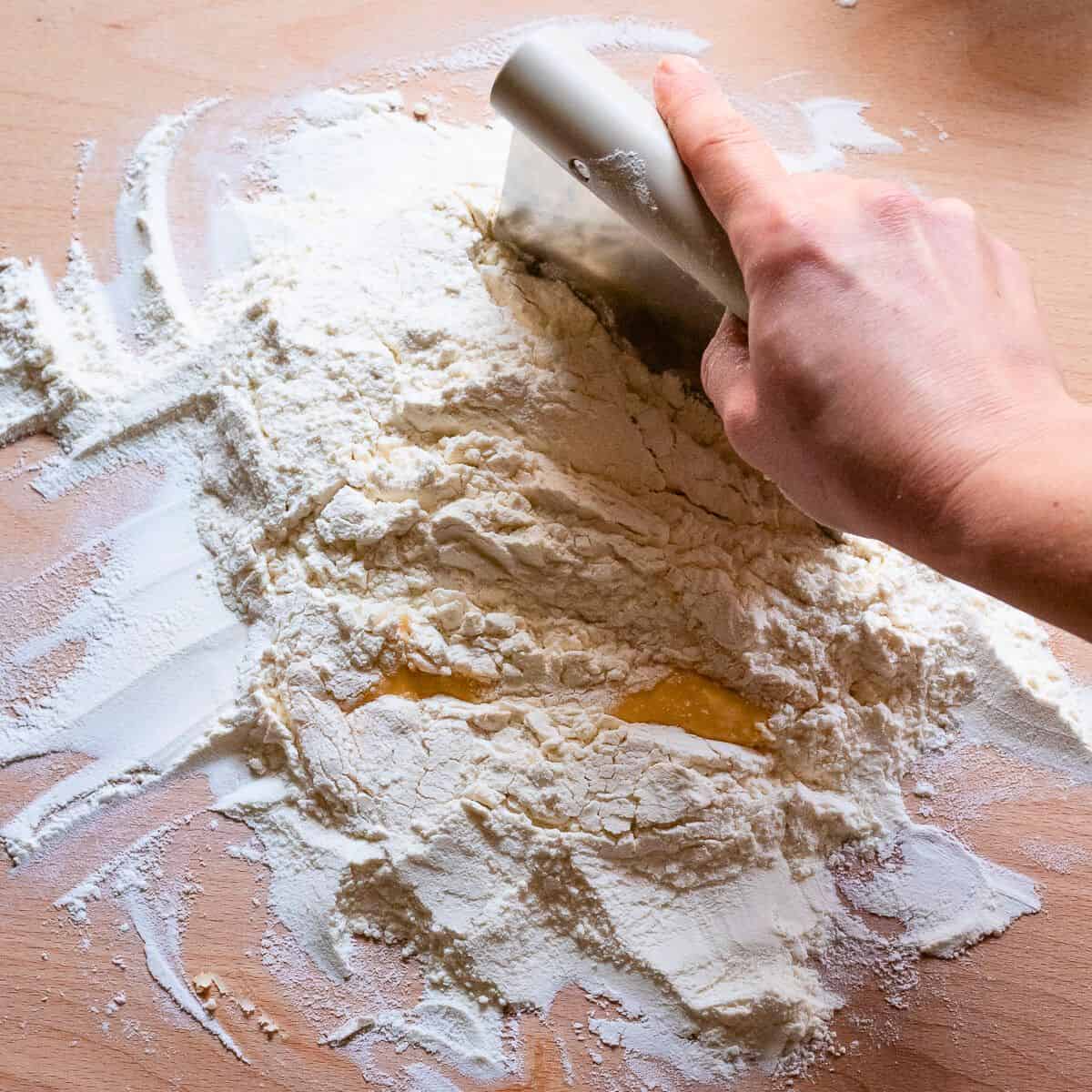
- Now using a dough scraper cut it into the egg mixture until little to no dry flour is left.
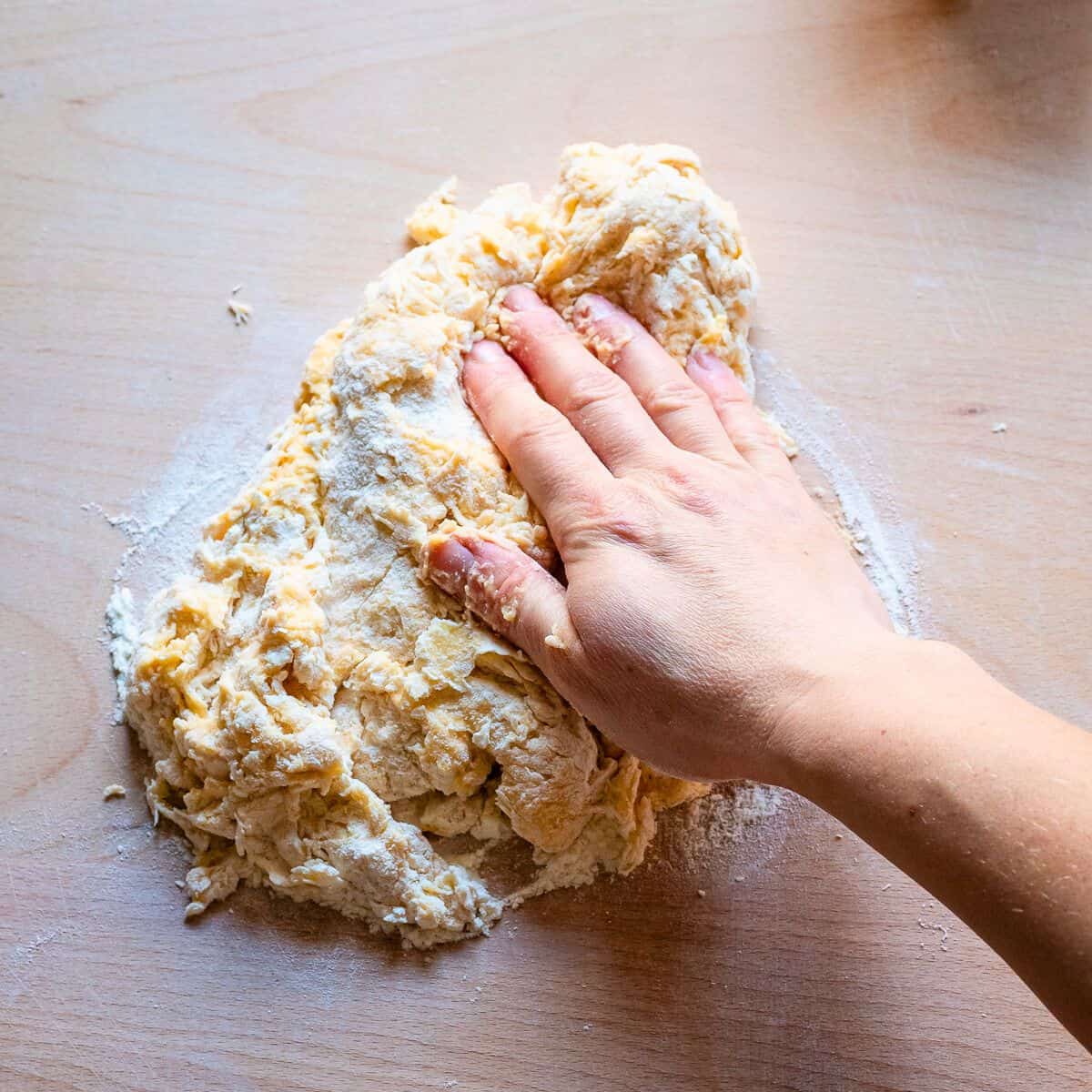
- Using your hands compact the dough pressing any loose bits of flour into the dough.
EXTRA TIP: Once a rough ball of dough is formed wash your hands and clean the work-surface from bits of the dough that were not incorporated. This way the dough won’t stick to the bits of the dough on my hands and work-surface.

- Lightly flour your hands and work surface. Start kneading the dough stretching and pressing it against the work-surface and folding it over itself. Turn the dough 90” and repeat. Add a slight sprinkle of flour but ONLY if the dough sticks to your hands.
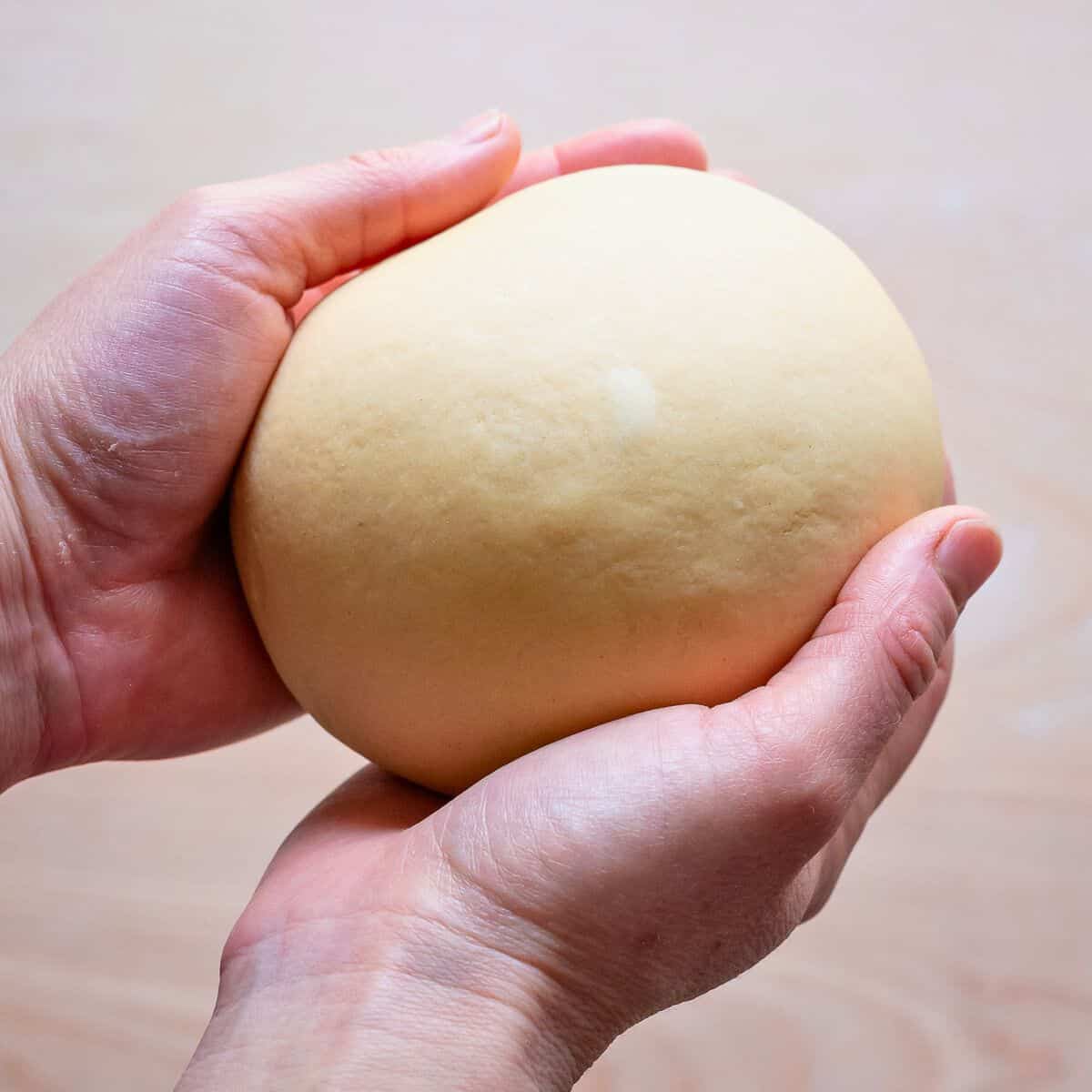
- As you work the dough rotating it several times it won’t stick anymore. There’s no need to knead energetically, slow and firm motions are the best. Knead the dough in this manner for about 10 minutes.
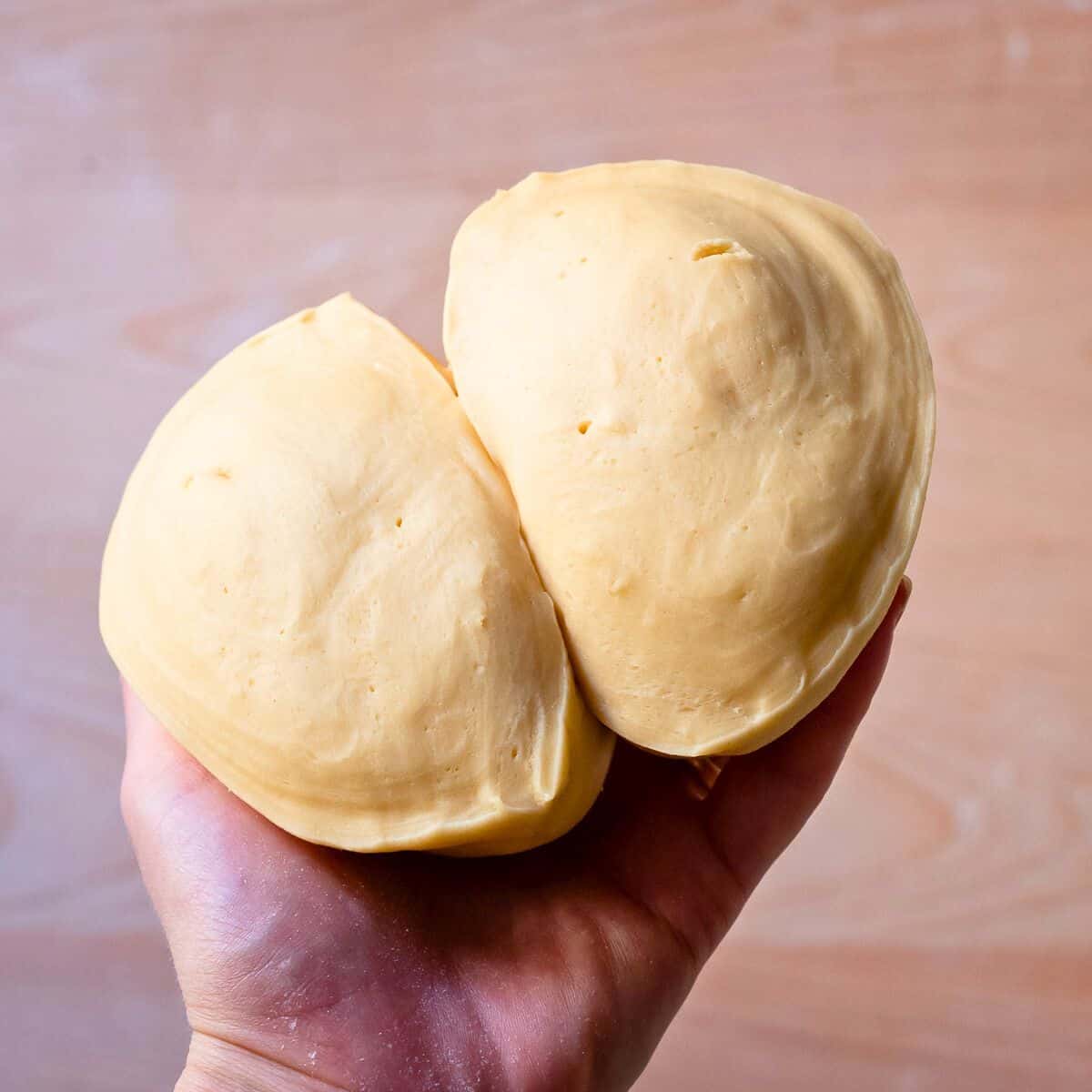
- How do I know if the dough is ready and when should I stop kneading?
The dough is ready when it is smooth, soft to touch but not sticky. Also, you cut it in half you should see small air bubbles which is a sign that the dough was kneaded to perfection.
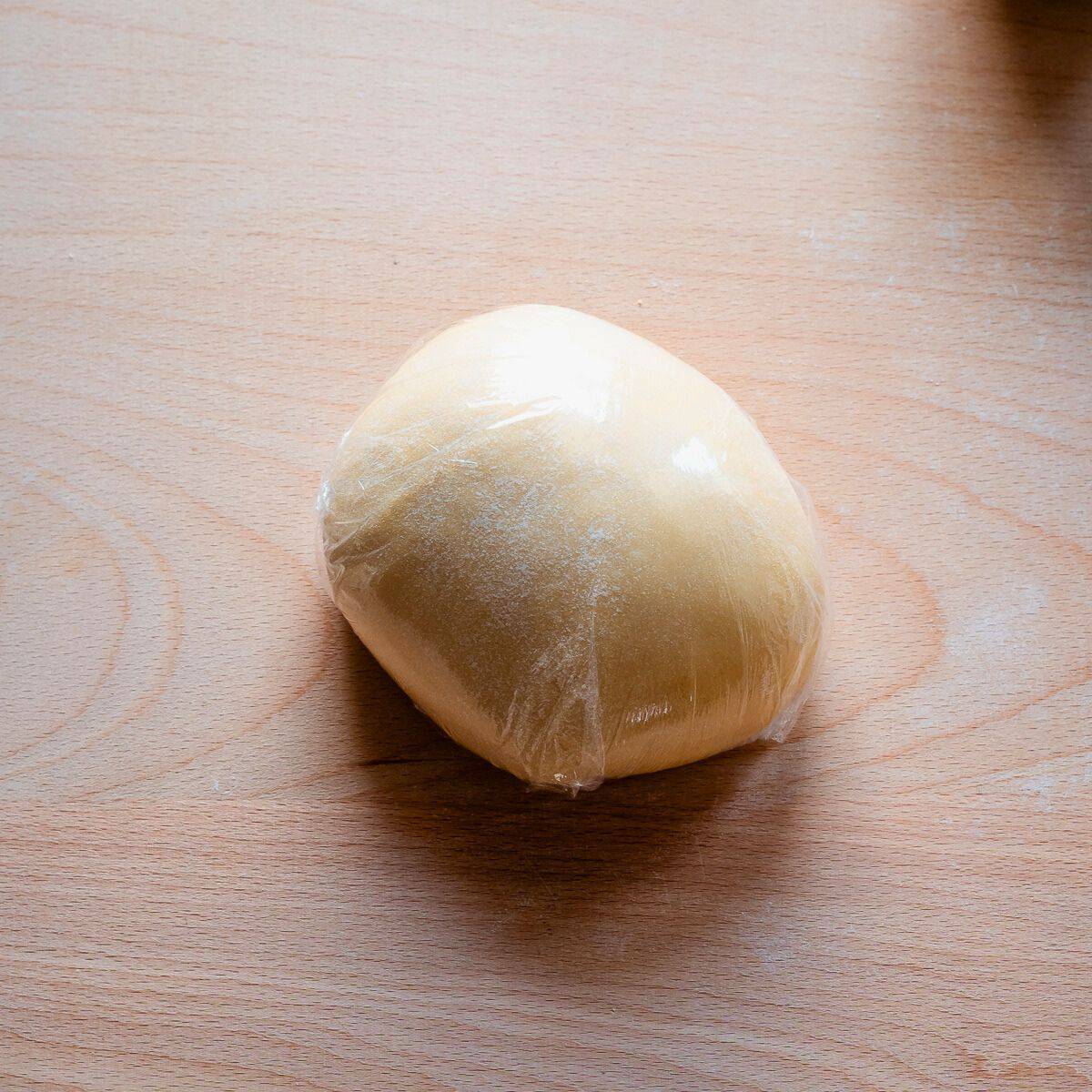
- Form a dough ball, dust it lightly with flour and wrap in a plastic wrap or put in a ziplock bag. Let rest for 30 minutes (for up to 2 hours at room temperature or up to 8 hours in the fridge) before rolling.
How To Store Fresh Pasta Dough
You can store freshly made pasta dough in the fridge for up to 8 hours. It's best to work it within that time rage since storing it for longer will start oxidization process and turn its color from yellow to grey.
If you absolutely can't work your egg dough the same day, it will be still good to use within 24 hours after making it (stored in the fridge). Just keep in mind that it might change in color.
Variations
- Extra egg yolk. One of the main characteristics of egg pasta dough is its rich color that comes from using free-range high quality fresh eggs with bright orange egg yolk. If the egg yolk is pale it's possible to add an extra egg yolk for every two or three eggs.
- A mix of flours. Instead of using only Italian 00 flour, try using half semolina flour half 00 flour. A mix of semolina and white flour will produce a toothier, more porous and more al dente pasta, typical to the south.
FAQs
Yes, you can combine eggs and flour in a food processor or in a bowl with a simple handheld mixer using a dough hook. Once the dough comes into a ball, cover it with plastic wrap, let rest for 5-10 minutes then finish kneading it by hand.
Kneading pasta dough by hand improves its texture, elasticity and most importantly, aerate it. All these characteristics effect how pasta tastes when cooked.
Pasta dough doesn't need any salt since it will be cooked in plenty of salted water. In fact, adding salt to the dough will make it harder to knead.
Recipes Using Egg Pasta Dough

Love Italian Food?
Sign up for our weekly newsletter to receive tips, tricks and new recipes delivered straight to your inbox!
Full Recipe

Egg Pasta Dough (Perfect Every Time!)
Ingredients
- 3 eggs , preferably free range, see note 1
- 300 g flour , if the total egg weight without shell is 176 grams, see note 2
Instructions
Before you start
- Weight the eggs and note their total weight without eggshells.
- Calculate how much flour you need: egg weight in grams multiplied by 1.75
- Weight the amount of flour needed. Have a little extra flour ready on the side to use if needed.
Prepare the dough
- Sift flour and mound it on a large work surface or in a large bowl. Scoop a well in the center and add the eggs.
- Beat the eggs with a fork and start incorporating flour from the sides of the well into the egg mix, incorporating a little at a time to avoid the formation of lumps.
- Once egg mixture becomes thick enough so it doesn’t leak from the sides of the well, cover it with the remaining flour. Using a dough scraper cut it into the egg mixture until little to now dry flour is left.
- Using your hands form a dough ball pressing any loose bits of flour into the dough.
- Top Tip: Once a rough ball of dough is formed wash your hands and clean the work-surface from bits of the dough that were not incorporated. This way the dough won’t stick to the bits of the dough on my hands and worksurface.
Knead the dough
- Lightly flour your hands and work surface.
- Start kneading the dough stretching and pressing it against the work-surface and folding it over itself. Turn the dough 90” and repeat. Add a slight sprinkle of flour only if the dough sticks to your hands. As you work the dough rotating it several times it won’t stick anymore. There’s no need to knead energetically, slow and firm motions are the best. Knead the dough in this manner for about 10 minutes.The dough is ready when it is smooth and soft to touch. If you cut it half you should see small air bubbles which is a sign that the dough was kneaded to perfection.
- Form a dough ball, dust it lightly with flour, and wrap in plastic wrap or put in a ziplock bag. Let rest for 30 minutes (for up to 2 hours at room temperature or up to 8 hours in the fridge) before rolling.
Notes
- See the Step By Step Pictures for a visual walk-through of the recipe.
- Use a kitchen scale to measure all ingredients in grams.
Nutrition
Nutrition information is automatically calculated, so should only be used as an approximation.


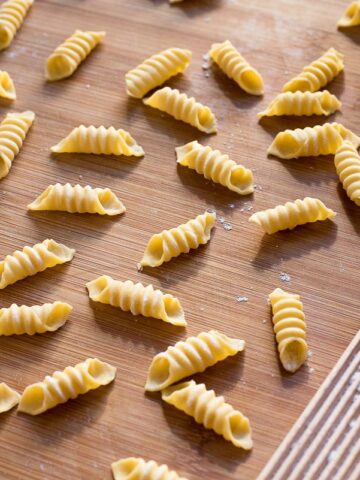
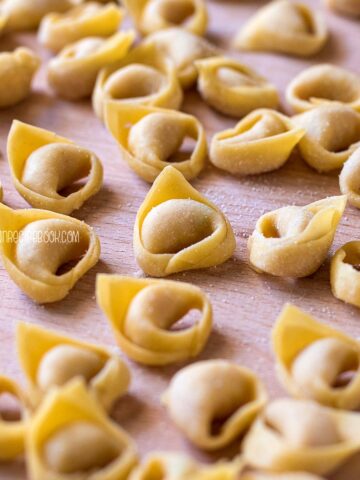
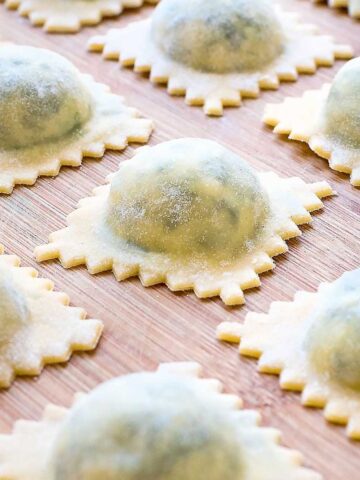
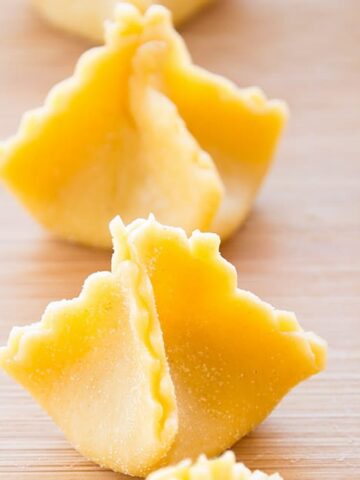
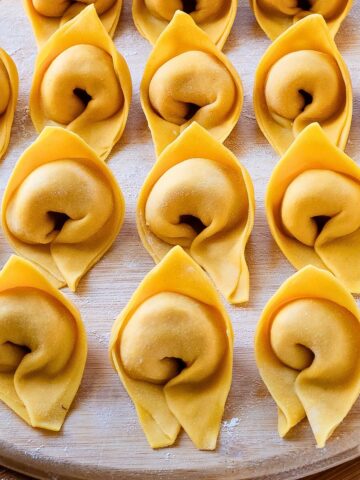
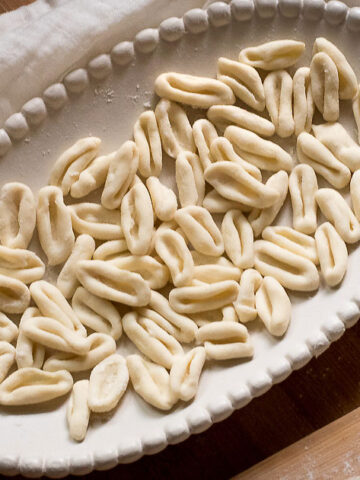
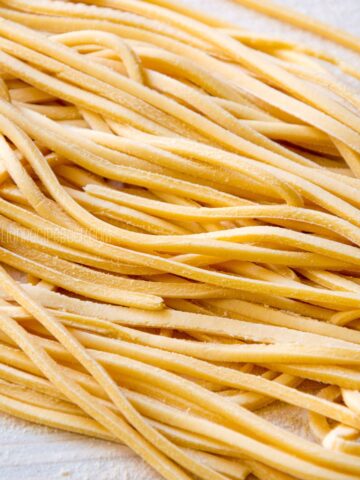
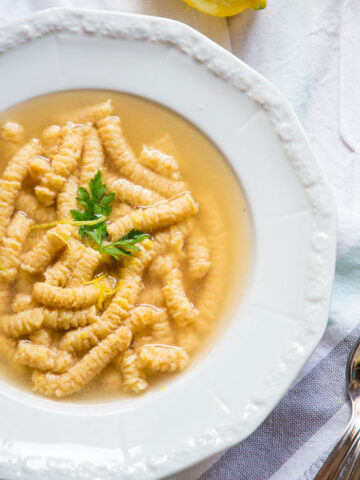
Eugenia says
It seems great!. I’ll try definitely! Thanks
Tony Donnarumma says
It is the best possible explanation of a recipe, learned a few tricks. I have a question, living in Thailand now, the choice of flour is limited, I can get 00 but not sure of the reputable brand. From an Italian recipe for Panettone and others, I was of the impression that "Farina Manitoba" was the best and I was able to buy online from an importer. So, can I use this flour for Pasta making or is this flour only dedicated for other types of Dough for Panettone etc. Thank you
Svitlana says
Hi Tony, glad you learned something new from my recipe.
As to your questions, probably the most represented Italian flour brand worldwide is Caputo. From their line look for "Pasta Fresca and Gnocchi". Having said you can use ANY other "00" flour that's available in your country and even all-purpose will work!
As for Manitoba flour you have, use it for long leavening baked goods. If you need to use it soon (close expiration date) you can even mix it with whatever bread flour you have available and make bread, pizza, focaccia and milk rolls etc.